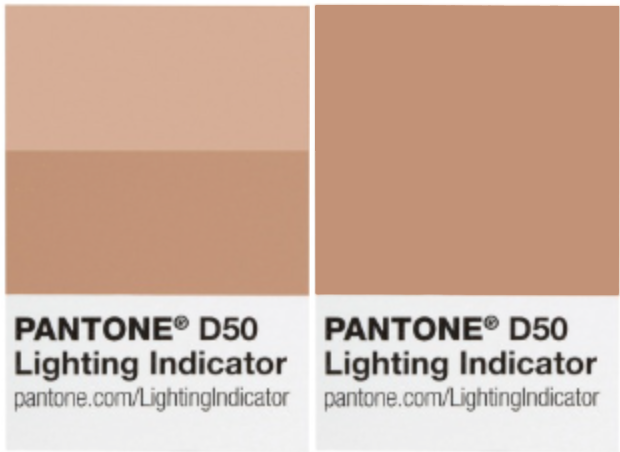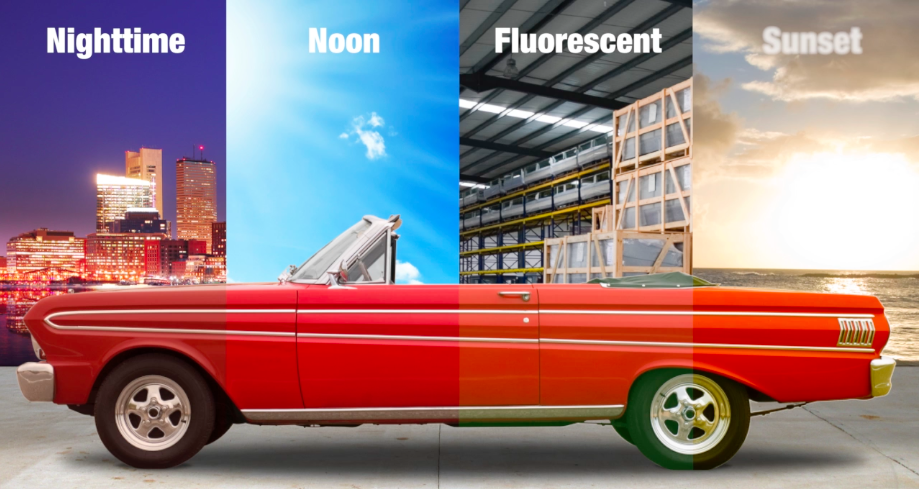色は大事だと、よく言われています。なぜ大事なのか知っていますか。実際、生産工程において、色はとても重要な要素です。しかし、残念ながら、多くのメーカーは、色を正しく表現することが以前と比べ、はるかに難しくなったと気づいています。なぜなら、取引先のブランドは、より厳しい許容範囲を満たすことを求めています。

その理由の一つは以下のとおりです。
メタリックパッケージ、真珠光沢仕上げ、カスタムファブリック、鮮やかな新色など、色技術の進捗は顧客を魅了する一方で、生産における一貫性を持たせることがより難しくなっています。
たとえば、コンポジットデッキを例としてあげましょう。以前はグレーかブラウンの2択しかありませんでした。そして、デッキ全体に調和が取れていけば、お客様は十分満足されました。しかし、今では、深い木目模様やエキゾチックな色など、多くの選択肢があります。そのため、メーカーは2~3色ではなく、数10色を管理しなければなりません。統一感を出すために、より難しくなりました。
パッケージもそのひとつです。かつて、印刷された箱のみが並んでいたお店でも、今はホイルパウチやブリスターパック、マルチ基板を使ったディスプレイが並ぶようになりました。とくに、反射材や半透明材は色のコントロールが難しく、ある面ではうまくいっても、別の面ではうまくいかないこともあります。
パッケージデザインも棚に見られます。ここでは、パウチ、ラベル、カートン、段ボールなど、視覚で不一致が見られますが、これらは克服できる問題です。

以前は合格していた色でも十分ではありません。
テキスタイルからプラスチック、塗料、コーティングに至るまで、どの業界でも同じです。そして、消費者とブランドオーナーは、より厳しくなっています。なぜなら、色が正しく実現できないと、消費者はパッケージに問題のある製品を通り過ぎて、競合ブランドの製品を購入してしまいます。結果、不合格となった製品はしばしば無駄な在庫となってしまいます。
ブランドや印刷会社、メーカーに多大なストレスを与えています。あなたも、このような状況に陥っていませんか?
- 色を評価するために、日光の下に出ていますか?
- 他の人が評価・承認を出来るように、写真をメールで送信していますか?
- どのような色を期待しているか、はっきりしていますか?
- 以前は合格だった色が、今では拒否されていませんか?
これらの質問のいずれかに「はい」と答えた場合、あなたの視覚評価プログラムには、改善の余地があります。幸いなことに、安定した色を実現するための第一歩を踏み出せるため、多くの時間や、お金、労力は必要ありません。
ここでは、視覚評価プログラムにおいて、うまくいってない原因について考えてみましょう。
1- 間違った照明
以下の画像は、標準光源で照明することがとても重要なことを示しています。光源の種類によって、赤の色合いが変化していることがおわかりいただけますか?
 しかし、現在使用している研究室やオフィスの光源が標準かどうか、わからない場合はどうすればよいでしょうか。 無理をして期待しないでください。>PANTONE® LIGHTING INDICATOR ステッカーで、試してみましょう。各ステッカーには2つのパッチがあります。この2つが一致すれば、目的の光の下で仕事をしていることがわかります。もし、一致しなければ、色を決定する前に別の光源に移動する必要があります。
しかし、現在使用している研究室やオフィスの光源が標準かどうか、わからない場合はどうすればよいでしょうか。 無理をして期待しないでください。>PANTONE® LIGHTING INDICATOR ステッカーで、試してみましょう。各ステッカーには2つのパッチがあります。この2つが一致すれば、目的の光の下で仕事をしていることがわかります。もし、一致しなければ、色を決定する前に別の光源に移動する必要があります。
もちろん、LIGHTING INDICATORステッカーでは、店舗やオフィス、家庭にある蛍光灯、白熱灯、LEDなどの照明の下で、色がどのように見えるかわかりません。完成した製品が世に出たときにどのように見えるかを知りたいときには、標準光源装置を利用することをおすすめします。
とくに、背面がプラスチックで側面がゴムの携帯電話ケースや、自動車のサイドミラーなど、最終製品に組み合わせる部品を製造する場合は、とても重要です。日光の下で「ゴールデンサンプル」と呼ばれるような、物理的な基準に一致したからといっても、店舗やショールーム、家庭の照明の下でも美しく見えるとは限りません。
標準光源装置は大きな投資が必要なく、不合格になる製品が減れば、すぐ費用対効果が見られます。標準光源装置の仕組みについては、「色を視覚で評価するための10つのヒント」(英語版)をご覧ください。
2- 色覚は完璧ではありません
ほとんどの人は、自分が何らかの色覚異常を持っているかに、気づいていませんが、これは非常に一般的なことです。実は、男性の約13人に1人、女性の約300人に1人の割合で何らかの色覚に異常があると言われています。

これが「石原式色覚異常検査表」です。左の丸に「6」、右の丸に「2」が見えない人は、何らかの色覚異常がある可能性があります。
もし、あなたは色を決定する責任者なら、色彩テストを受けるべきです。これは、色と外観の基礎セミナーの一環として行われます。オンラインでのカラーチャレンジは、あなたの色覚が楽しく、素早く理解できる方法です。
3- 間違った物理的基準
もし、あなたが物理的な色標準を使うなら、それは素晴らしいことです。いくつかの基本的なガイドラインに従う限り、これらは色を伝え、評価するための正確な方法です。
まず、適切な基材から作られる必要があります。例えば、タオルに使われる生地を生産しているとしましょう。紙の基準で生地の色を評価しても、正確な結果は得られません。顔料、染料、インクによって素材の性質が異なるため、同じ素材から作られたものでなければ、色を正しく判断できません。これは多くのメーカーにとって大きな問題点です。
しかし、あらゆるものと同様に、物理的な標準にも汚れ、染み、色あせの影響を受けます。物理的な標準の究極のお手入れのガイドは、サンプルを最高の状態に保つことです。
4- デバイスの色が統一されていない
家電販売店のショールームで、壁一面の新型テレビの色が全く違うことが気づいたら、デバイスの色の一貫性に問題があることがわかるでしょう。しかし、私たちは、携帯端末やパソコンを使って色を決定するときに、このようなことは考えていないでしょう。あなたのデジタルカメラは正しい色を捉えていましたか?。また、写真を送って承認を求めている相手は色を正しく見ていますか?。
写真を電送することは、色を決めるための最良な方法ではありませんが、物理的なサンプルを共有することが不可能な場合は、より良い選択肢ではあります。しかし、関係するすべてのデバイスのカラーキャリブレーションを行う必要があります。
視覚評価に頼っていませんか。?
優れた色彩評価は、常に進化している旅のようです。新しい基材や製造工程がカラーコントロールプログラムを混乱させることがありますが、カラーツールも、より賢くなっています。あらゆる方法を活用して、本来の色を取り戻しましょう。
すでに標準光源装置や測色計を使っている方は、すでに、次の色の段階にいます。今後のブログで次のレベルに進めていきますので、お楽しみに!
おすすめの製品一覧
 |
ファンズワース・マンセル100色相テストFM100色相テストは、簡単に実施できるテストであり、個人の色彩識別能力を評価するのに非常に有効な方法です。 |
 |
Judge QCクラスBの昼光とオプションのLEDを含む5つの光源を備えたこのコンパクトなエントリーレベルのライトブースです。コントロールされた照明の下で小さなサンプルの色を視覚的に評価するための経済的な方法です。 |
 |
eXact 2シリーズ市場で初めて特許を取得したMantisTMビデオターゲットやデジタルルーペ技術などの革新的な機能を備えたeXact 2は、ブランド、プリンター、コンバーター、インクサプライヤーにとって理想的な製品です。 |


